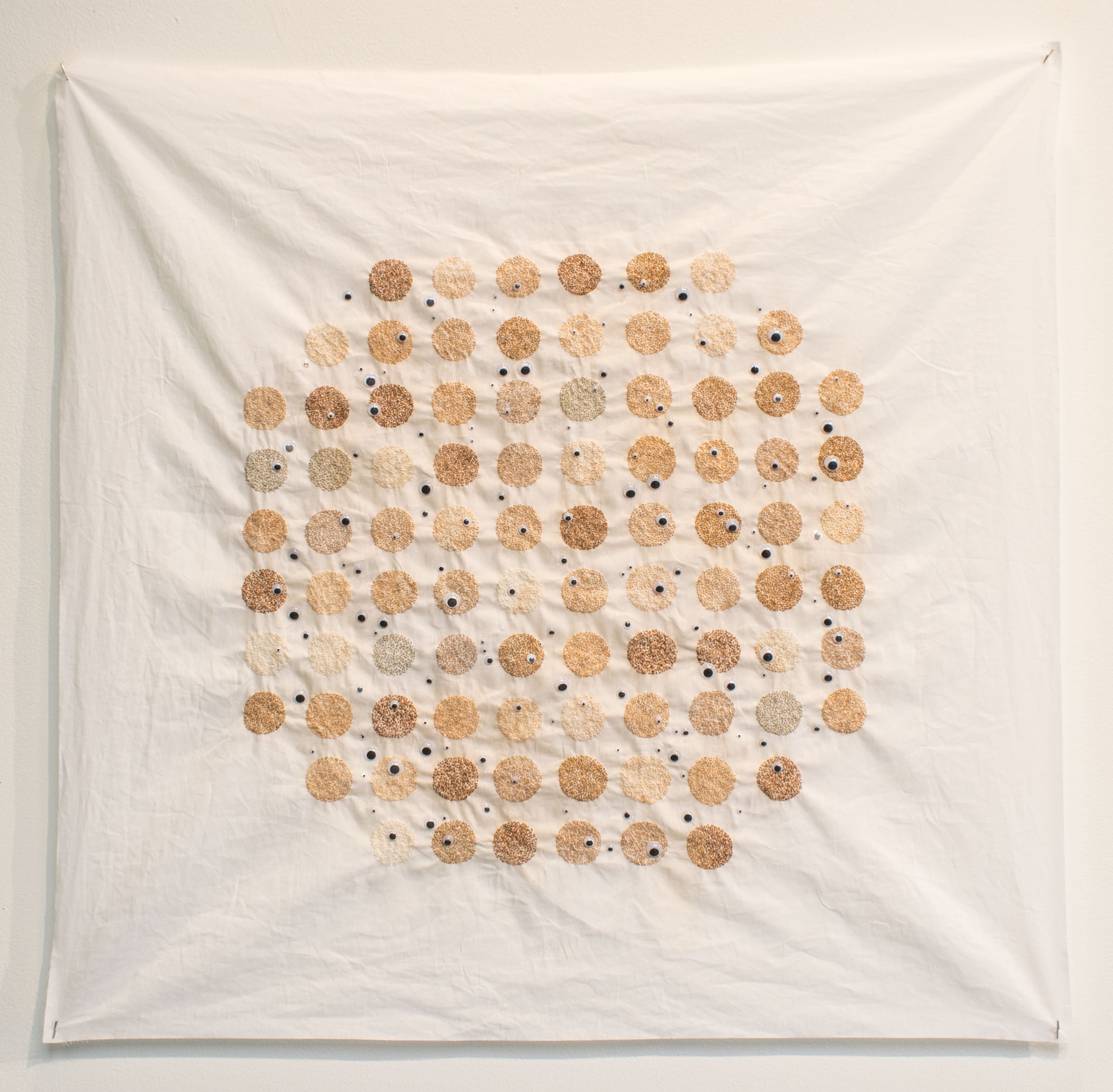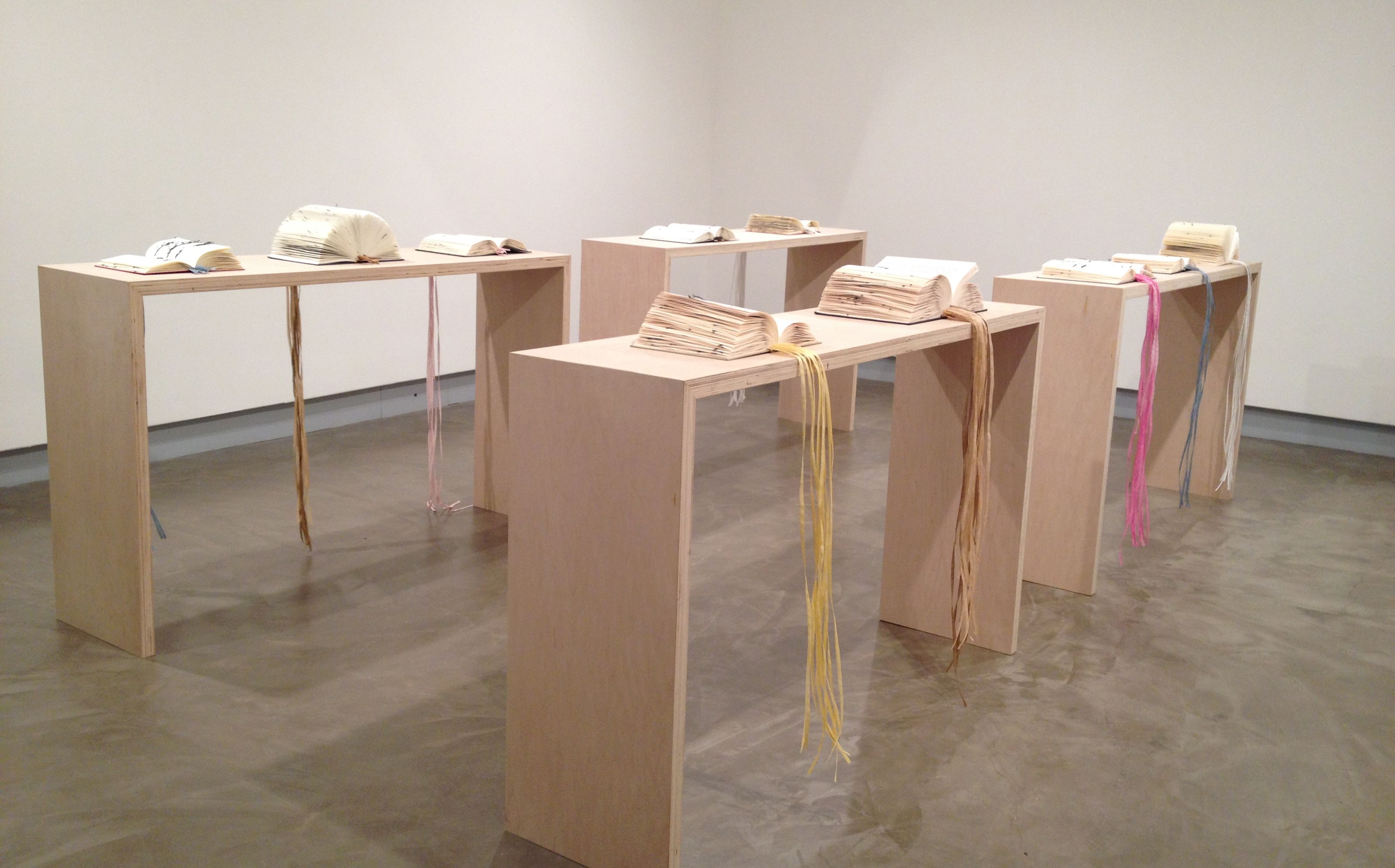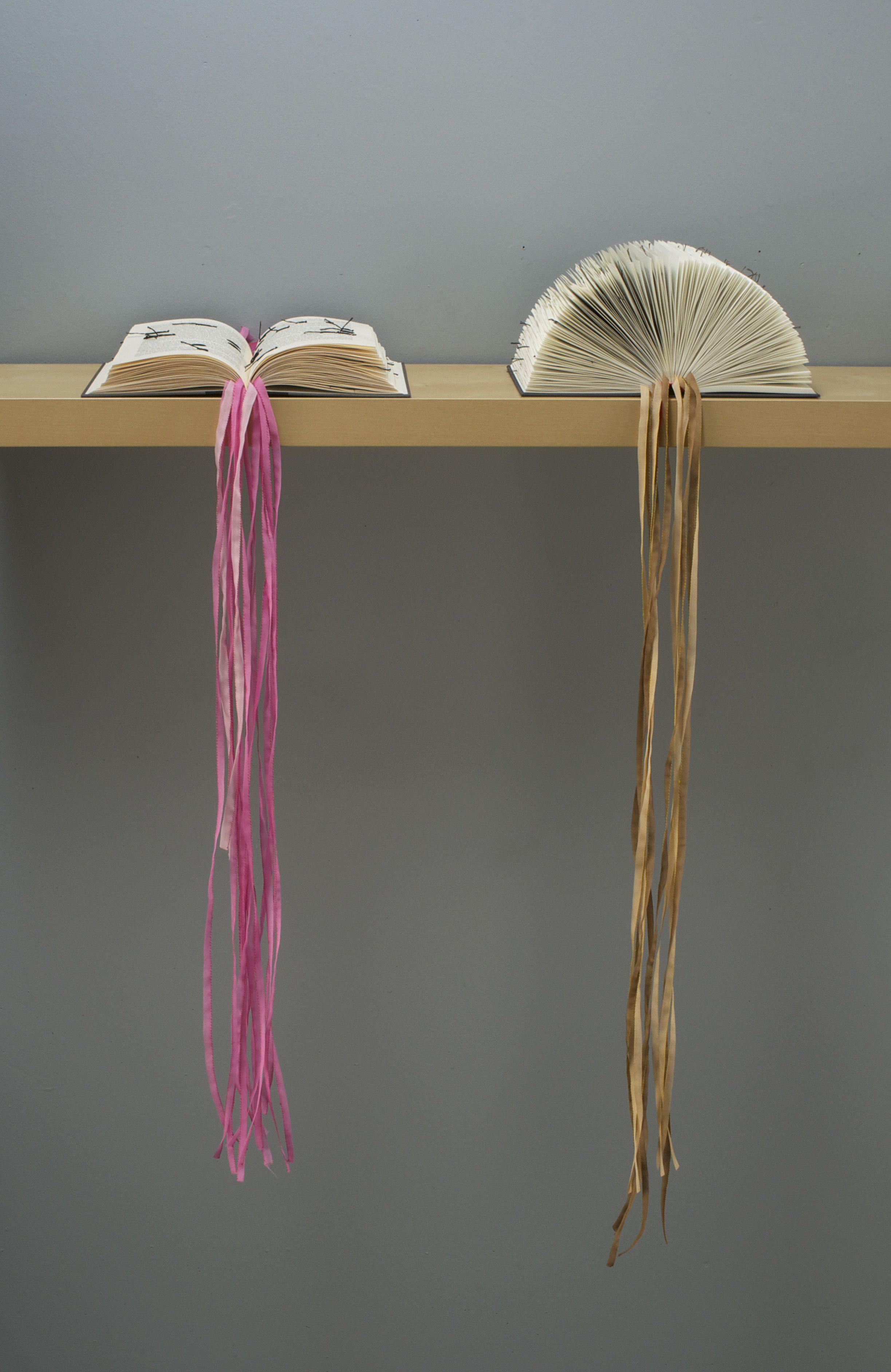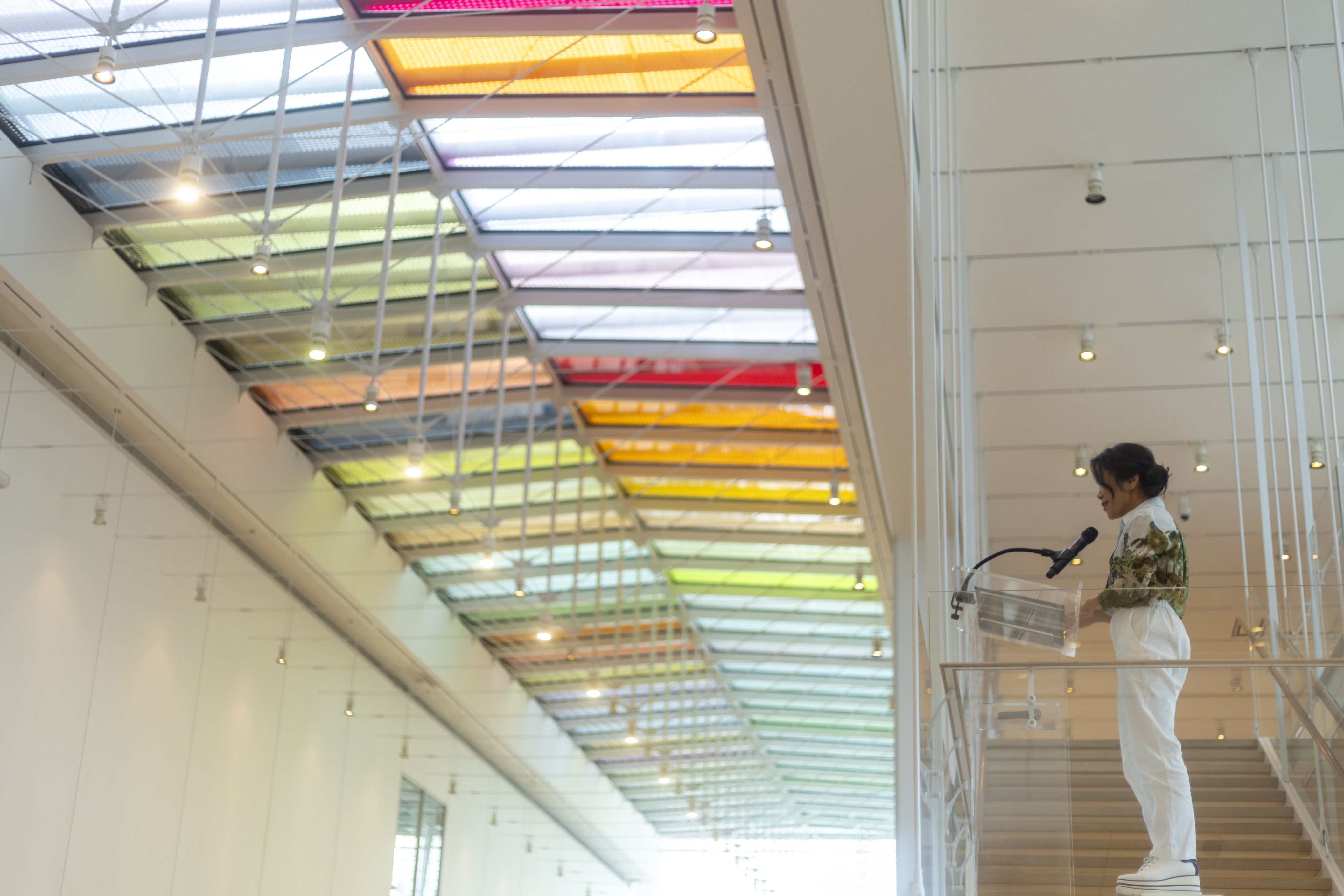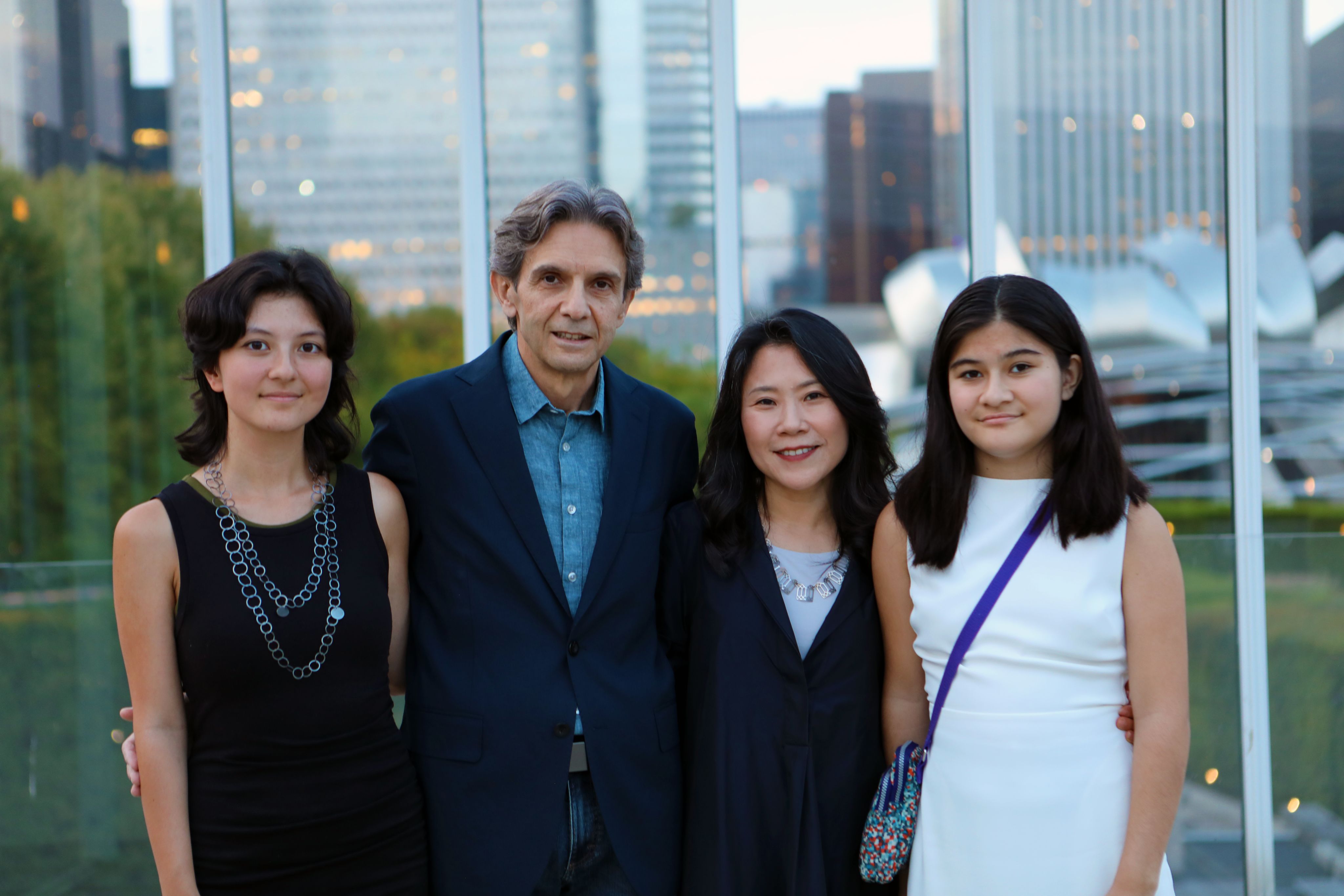Woven In:
Creating a Shared Vision with Jiseon Lee Isbara

by Sophie Lucido Johnson (MFA 2017)
Consider: a white fabric square pinned to a gallery wall, with 88 hand-embroidered circles, each in a different dyed-thread shade ranging from eggshell-pink to dark mahogany. Dispersed throughout are plastic googly eyes in various sizes, seemingly glaring, unblinking, at the circles. This is Stare, a textile work by Jiseon Lee Isbara from 2018. In careful abstract detail, it depicts, at least in part, her own experience as a Korean American woman in public spaces in the United States, where people reliably stare at her, sizing up her particular brand of difference.
Jiseon Lee Isbara, Stare, 2018.
Jiseon Lee Isbara, Stare, 2018.
Or: 10 books opened on four wooden tables, with words stitched through with black thread and long, multihued ribbons bisecting many of the page spreads and hanging toward the ground. Top Ten Books To Read Before You Die features the 10 books Amazon attests that all living people should consume—but Lee Isbara used embroidery thread to black out any of the words she didn’t understand when reading the books in English (her second language), and she added a ribbon any time she was interrupted by one of her daughters needing something from her. Moby Dick’s pages are so filled and splayed that closing the book has become impossible.
Lee Isbara has lots of textile installations like these: pieces that are concerned with her identity as a female Asian immigrant in America; as well as an academic who is necessarily concerned with language; as well as a mother, a wife, a daughter, and a citizen of the world. Her work is gorgeous, intricate, and unmissable. For all its seriousness and thoughtfulness, it’s also often silly and approachable, and crucially, it tends to ask more questions than it answers.
“I do not think that what lies ahead for SAIC should be solely realizing my vision. I think it’s got to be the School's vision.”
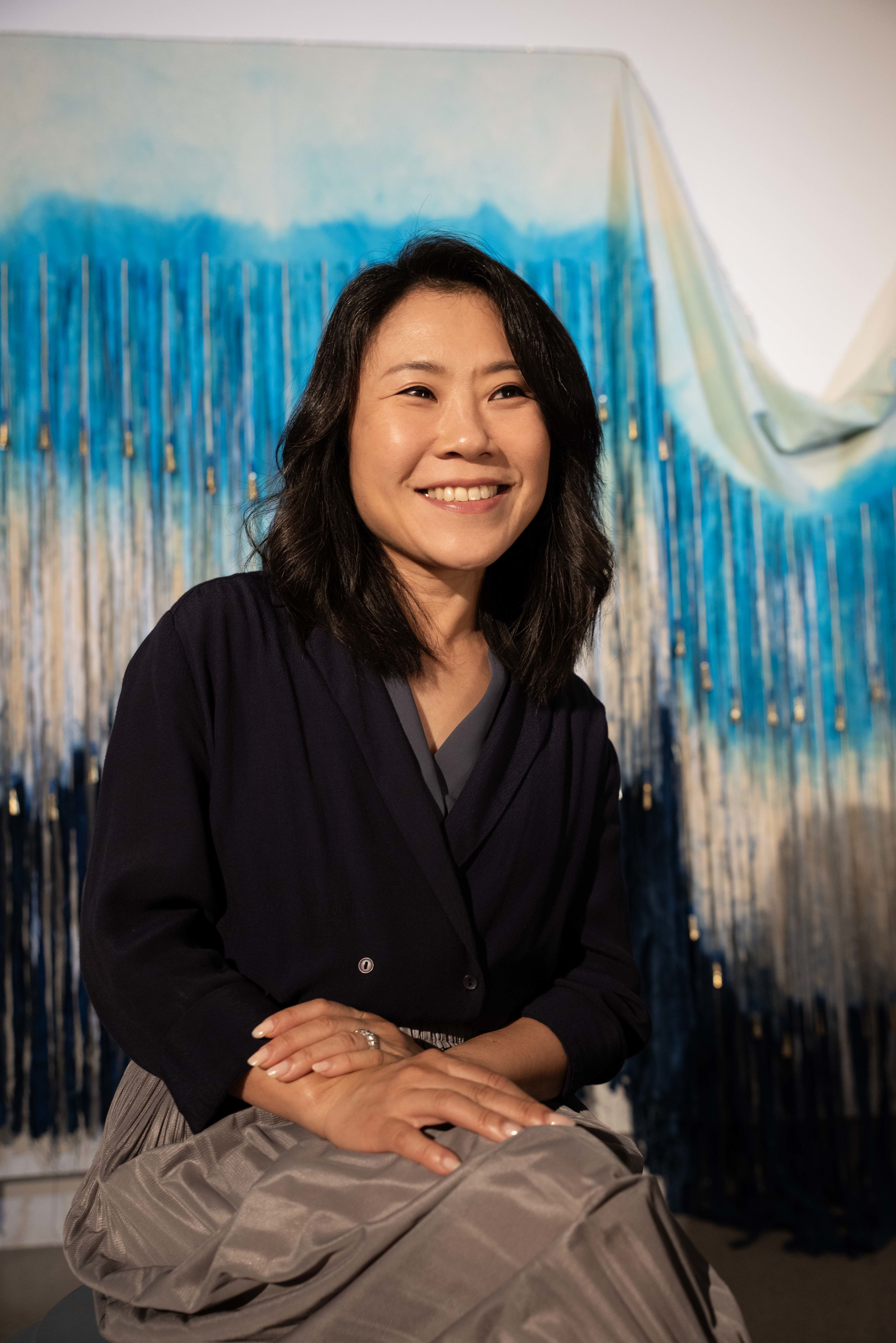
This is the spirit Lee Isbara is bringing to her next project, and it’s a big one: in July, she became the president of the School of the Art Institute of Chicago (SAIC). Like her work, she’s not coming with answers or a set-in-stone plan. Really, her first intention is to spend a great deal of time listening.
“I do not think that what lies ahead for SAIC should be solely realizing my vision,” Lee Isbara said. “I think it’s got to be the School's vision.”
In tandem with her creative talent, Lee Isbara’s experience as an accomplished administrator is another reason she was chosen to lead the School into its next era. She has two master of fine arts degrees in fiber, one from Colorado State University and the other from Ewha Womans University in Seoul. She went on to serve in several roles at Oregon College of Art and Craft, including head of the fibers department, dean of academic affairs, and interim president. Eventually, she came to serve as provost at Otis College of Art and Design in California. There, she implemented a five-year strategic plan that resulted in substantial positive changes at the school around enrollment, mental health, career preparedness, and diversity, equity, and inclusion.
Lee Isbara's Top Ten Books To Read Before You Die project tackles the western literary canon.
Lee Isbara's Top Ten Books To Read Before You Die project tackles the western literary canon.
In Top Ten Books To Read Before You Die, Lee Isbara used embroidery thread to black out words she didn't understand, and added a ribbon each time her daughters interrupted her reading.
In Top Ten Books To Read Before You Die, Lee Isbara used embroidery thread to black out words she didn't understand, and added a ribbon each time her daughters interrupted her reading.
Lee Isbara wants her time at SAIC to be shaped by the needs and desires of current students, staff, faculty, alums, and stakeholders. She acknowledges that SAIC, like many other higher educational institutions, has endured recent challenges, including those brought on by the pandemic. In order to best lead the School, she wants to connect with community members in meaningful ways, and let those discussions guide her.
Maybe this openness to ambiguity comes in part from Lee Isbara’s own personal and family history. Both her father’s and mother’s families were originally from Northern Korea (now North Korea), and came to the South as refugees during the Korean War. They came with nothing, and always planned to move back to the North, but were never able to.
“The story of my family and the difficulty they had to pull through to become who they are now [is the story of] why education is so important,” Lee Isbara said.
She grew up living with her parents and all of her aunts, next door to both sets of her grandparents. She knows now that living with her extended family influenced her more than she realized at the time. Her grandmother was an accomplished textile artist, knitting, sewing, and making things with fabric and thread. Lee Isbara grew up watching her and credits her grandmother with much of her own aesthetic, work ethic, and value of labor. When she went to college, she chose fibers as her major because it came so naturally to her.
In many of her lectures, Lee Isbara shows a spoon case her grandmother made—a family heirloom and the only object that her family brought with them to South Korea. The spoon case is hand-embroidered with east Asian symbols to bestow luck, health, prosperity, and the like. Lee Isbara cherished the spoon case, and nobody objected when she brought it to the US with her.
Lee Isbara acknowledged that the spoon case represents, in some ways, patriarchal society. None of her aunts were given a spoon case: Lee Isbara’s father, as the first-born male, was bestowed with a great deal of significance. But it’s appropriate that the spoon case is complicated, imbued with meanings at once powerful, beautiful, and heartbreaking. That’s the complexity that Lee Isbara embraces, not only in her work, but in her capacity as an educator and leader.
Accolades aside, Lee Isbara brings with her a life story that’s filled with the kind of richness and multitudes present in the stories of so many students at SAIC. She’s the School’s first first-generation immigrant president, and only its second woman president.
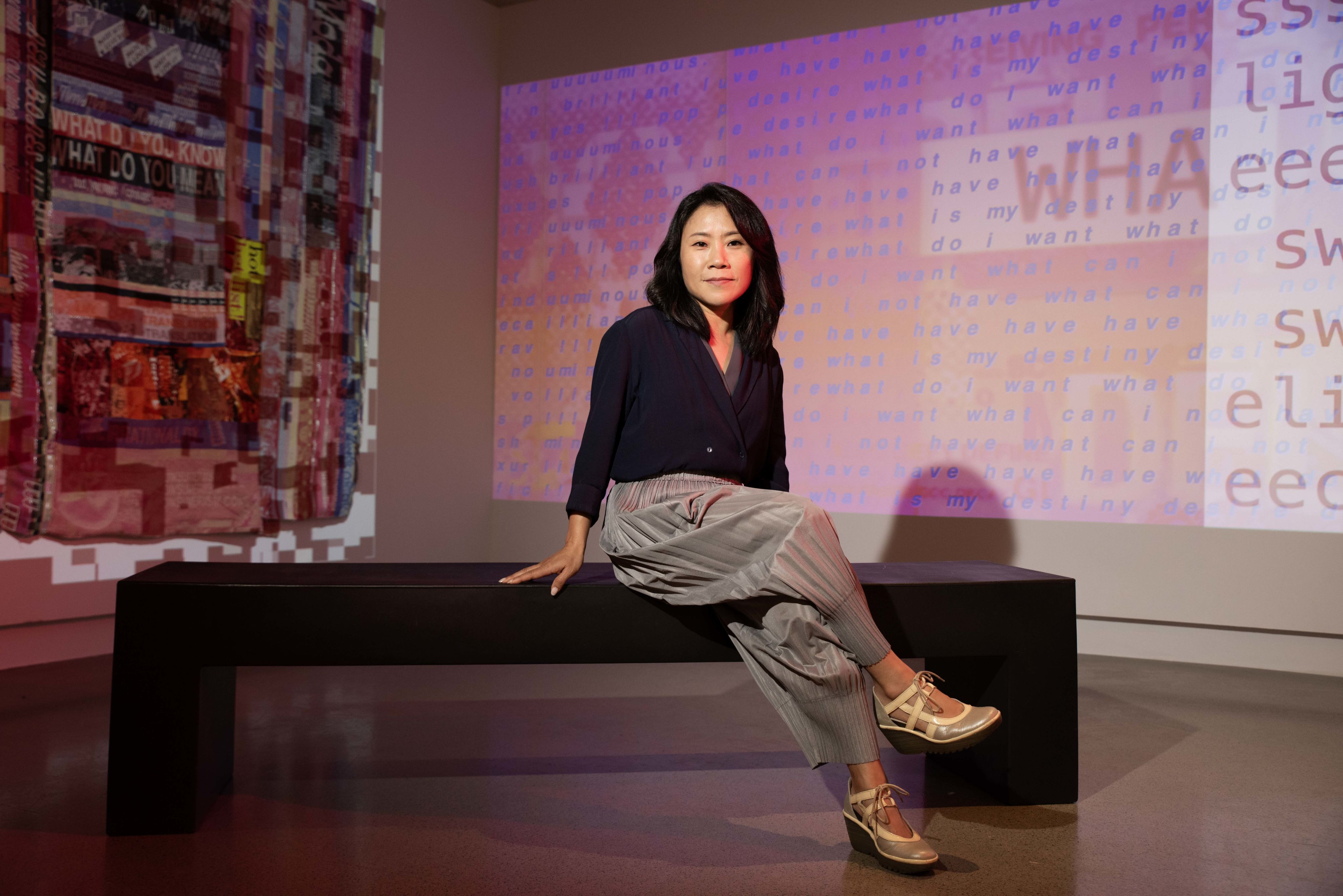
“After I came to the US, one of the most frequently asked questions was how my Korean-ness was demonstrated or explored in my art,” Lee Isbara said. “You could imagine that that was never asked when I was in Korea.”
She noticed that her work was constantly being critiqued through a Eurocentric Christian lens—one that she hadn’t necessarily been thinking about when she was making art in Korea. She’s felt frustrated by the assumptions people have made about her, and about the tokenism she’s experienced as an immigrant in both the art world and in higher education.
But Lee Isbara isn’t interested in feeling sorry for herself, or turning down opportunities to be a part of the change. She comes from a legacy of survivors, and she knows how to turn adversity into curiosity.
“I quickly learned, ‘If I’m gonna have a seat, I’m gonna utilize this seat,’” she said. “There must be something I can contribute to. So, I’m going to contribute.”
During move-in day, Lee Isbara and other administrators came to campus to lend a helping hand.
During move-in day, Lee Isbara and other administrators came to campus to lend a helping hand.
Lee Isbara addresses a crowd in the Art Institute of Chicago's Modern Wing.
Lee Isbara addresses a crowd in the Art Institute of Chicago's Modern Wing.
“The story of my family and the difficulty they had to pull through to become who they are now [is the story of] why education is so important.”
Lee Isbara and her family in Millennium Park.
Lee Isbara and her family in Millennium Park.
When Lee Isbara visited SAIC this past winter, she got right to work listening to what students had to say. She heard students voicing concerns about what they were going to do with their art and design degrees after they graduated, and how they were going to take the skills they developed at SAIC and create meaningful careers.
She wants to pay attention to what the college can do through its day-to-day operations to better position students as life-long artists, designers, and scholars. She wants SAIC to be a place where students already feel like valuable members of a global creative community. “What are the ways that we can actually celebrate artists?” she asked. “What role can we actively play?”
These conversations already informed the first of Lee Isbara’s goals as she arrives at SAIC: “To understand the careers students are going to have, what creative community they are going to belong to, how they are continuing their practice,” Lee Isbara said, adding, “I’m interested in discussing that further.”
As she has for her entire life and career, Lee Isbara is asking big questions. And as the new president of the college, with nothing but possibility in front of her, she is determined to follow the threads and find the answers. ■
Jiseon Welcomes the SAIC Community to the Fall Term

